RaceFans’ special contributor @DieterRencken notched up his 300th Formula One grand prix in Azerbaijan last weekend. He reflects on how the sport has changed – for better and worse – since he first entered the paddock in 1997.
For as long as I remember I have loved cars with a passion, more particularly those with numbers on their sides. As a kid I (successfully) pleaded with father to take me to motor races – we lived within earshot of Roy Hesketh Circuit in Pietermaritzburg, South Africa, where my parents were school teachers. Once able to cycle, I spared him the chore although, to be fair, he was partial to the sport when familial duties permitted.
The circuit hosted two SA F1 Championship rounds annually, so I tingled at nape-hair-rising sounds of Cosworth DFVs at 16, then two years later attended my first world championship F1 round at Kyalami – Denny Hulme won in a McLaren. But I never entertained any notions that I might one day consider grands prix Sundays to be my working days.
I fervently followed all forms of motor sport via magazines, books, newspapers and radio – SA first gained TV in 1977. Once I reached 16, I occasionally raced a spare kart belonging to a friend. At age 20, with paternal assistance, I acquired a used rally car and enjoyed some local and national successes during that pre-professional era.
But that, I thought, would be it.
Subsequently I dedicated myself to a career in the African motor industry. Yet a nagging feeling that I belonged elsewhere gnawed unabated. How, though, could a kid born in a rural South African village – with no contacts in international motorsport – hope to make it to the pinnacle of motorsport in any capacity? Such dreams were too preposterous for words, let alone reality.
(How I made the fortunate transition from corporate clown to F1 insider is told in this pair of recent interviews.)
Last weekend I swept my permanent pass at Baku’s turnstile on the occasion of my 300th grand prix. This was a personal milestone, though my triple century is far from a record. Numerous colleagues have hit 600, one is nearing 700 (remarkable considering Sunday’s race was the 980th world championship round). I admire them for their perseverance but take personal satisfaction from knowing that, as far as I have been able to ascertain, no colleague past or present, has funded the costs of every grand prix as a freelancer – as I have.
I recall that very first swipe, at Silverstone 1997 (above); the sheer exhilaration as I entered F1’s inner sanctum in my own right; of an overwhelming emotion that I was at last where I always knew I belonged. Then relief that I had “made it” washed over me. But I came to learn that belief was born of sheer naivety: One has never truly “made it” in F1 – there it is no easy ride, and every race presents yet another unique challenge.
Of course, during the past 300 grands prix F1 has changed enormously. Indeed, I hazard that F1 changed more in the past twenty years than it had in the previous 48, if for no other reason than F1’s commercial rights were hived off by Max Mosley’s administration to an entity controlled by his good friend Bernie Ecclestone. The deal was for 113 years, at what can now only be described as a knock-down price.
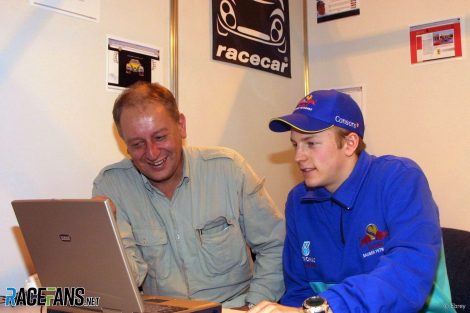 Getting the first interview with Kimi on the day he was announced as an F1 race driverMy first pass was issued by the Formula One Constructors Association – the teams’ union that shared F1’s TV and race hosting revenues – rather than Formula One Management, the Ecclestone company that assumed FOCA’s rights from 1998. Terms such as CVC, Strategy Group, Liberty Media and FWONK lay far ahead…
Getting the first interview with Kimi on the day he was announced as an F1 race driverMy first pass was issued by the Formula One Constructors Association – the teams’ union that shared F1’s TV and race hosting revenues – rather than Formula One Management, the Ecclestone company that assumed FOCA’s rights from 1998. Terms such as CVC, Strategy Group, Liberty Media and FWONK lay far ahead…
At the time FOCA (on behalf of all teams) and the FIA’s control of F1 was enshrined in the Concorde Agreement. This expired at the end of 1997, replaced by a tripartite covenant (the teams collectively, FIA and FOM), which had a ten-year tenure. In the interim (2006) the Formula One Group was acquired by venture vultures CVC Capital Partners. In my opinion, that was when the F1 I loved was devalued.
The ten-year deal was replaced by a (belated) 2010-12 agreement. After that a series of bilateral agreements (2013-2020) between the teams individually and FOG were forced through as CVC sought an IPO listing for the sport. Thankfully that failed to happen, and CVC sold the rights in January 2017 to Liberty Media, which reversed F1 into its own listing. This week the share price (FWONK) hit a 15-month low…
On-track the sport has changed dramatically, not always for the better. For one, 22 cars came under starters orders on that sweltering Sunday, with 11 finishing. It was the time before long-life engines and gearboxes, a single tyre supplier and reprimands for crashing, so the drivers raced hard all the way down the order, with mechanical and crash retirements being rife.
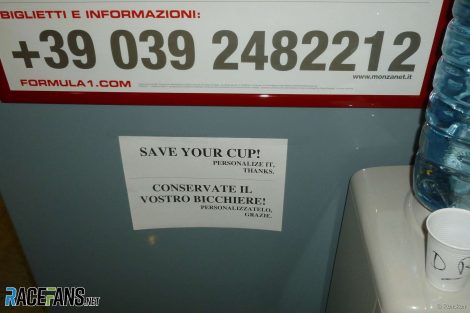 Media refreshments at Monza in 2007The winner that day was Jacques Villeneuve, who went on to the snatch the title in a finale at Jerez in October which sizzled with controversy. It remains the last time a non-European driver claimed the crown, and also the last time a European venue hosted the finale. Tellingly, Ecclestone was in the throes of signing up the first of the “showcase” races (Malaysia) which would debut in 1999.
Media refreshments at Monza in 2007The winner that day was Jacques Villeneuve, who went on to the snatch the title in a finale at Jerez in October which sizzled with controversy. It remains the last time a non-European driver claimed the crown, and also the last time a European venue hosted the finale. Tellingly, Ecclestone was in the throes of signing up the first of the “showcase” races (Malaysia) which would debut in 1999.
In 1997 virtually all cars bore allegiance to one or other tobacco brand – a notable exception being Stewart, then in its first year – and all boasted more sponsors than they could accommodate on-car. Within ten years tobacco sponsorship was banned, while backers became increasingly sparse as Ecclestone’s pursuit of pay-TV revenue, and the subsequent drop in viewers that caused, took hold.
Saliently, not a single team was then owned by a volume car producer, with the only non-hyphenated team on the grid being Ferrari. Within six years there would be no fewer than five teams owned by manufacturers – BMW, Honda, Jaguar, Renault and Toyota, with Mercedes holding a major slice of McLaren. However, that changed in 2009 as accountants tired of splashing out gazillions to watch their respective teams place seventh.
Advert | Become a RaceFans supporter and
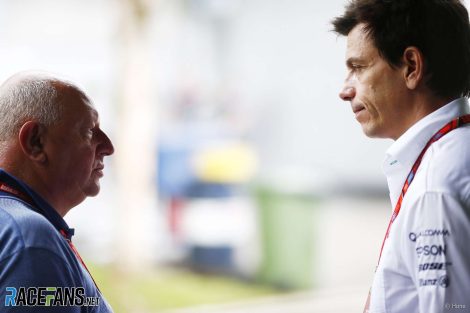 Talking budget caps with Toto WolffThat factor, concurrent demise of tobacco money, global economic crisis and gradual migration to pay-TV pushed F1 to crisis point in the late-noughties. That the sport survived is due to its global passion, and not due to any great effort on the part of then-commercial rights holder CVC – which almost lost F1 when the teams rebelled and threatened to form a breakaway series. In many ways I regret that they caved in so readily.
Talking budget caps with Toto WolffThat factor, concurrent demise of tobacco money, global economic crisis and gradual migration to pay-TV pushed F1 to crisis point in the late-noughties. That the sport survived is due to its global passion, and not due to any great effort on the part of then-commercial rights holder CVC – which almost lost F1 when the teams rebelled and threatened to form a breakaway series. In many ways I regret that they caved in so readily.
While F1 presently makes much noise about having four engine suppliers, current bosses would do well to peruse 1997’s entry list. No fewer than seven – Ferrari, Ford, Hart, Mercedes, Mugen, Renault and Yamaha – were represented, with engines then typically costing up to $40m for a season supply. Against that, budgets peaked at around $80m, so engines accounted for 50 per cent of spend.
2018 budgets run to $300m (plus), with engines pegged at around $25m, yet team bosses complain the power units are too expensive… while kicking against budget caps! 1997 feted six grand prix winners and 13 podium finishers; last year seven drivers, including five race winners, visited podiums.
The 1997 calendar listed 17 rounds – four less than this season – of which 12 (70%) were staged in Europe; this year the European contingent runs to nine (43%), while back then all venues were well-established. Today F1 speaks of Hanoi and Beijing as being the future while already having races in Shanghai and Singapore.
Tyres, too, underwent remarkable change: Goodyear had been the sport’s sole supplier in 1996, but F1 still operated to an open policy, and Bridgestone joined the fray in 1997. In time the former exited, but soon after Michelin came in, only to be hounded out ahead of a sole supplier deal awarded to Bridgestone, which supplied rock-hard tyres able to last a race (for a while, at Mosley’s instigation, these had circumferential grooves, a development widely disliked among drivers).
In 2011 the Japanese company was replaced by Pirelli, having been given a brief to ‘improve the show’ by producing rubber which degraded quickly, but only after they had committed to a ‘bridge-and-board’ signage. Thus, money that could conceivably be spent on-track now ends up in Liberty’s pockets, the teams pay for their tyres yet their drivers are required to wear Pirelli caps on the podium instead of not team wear.
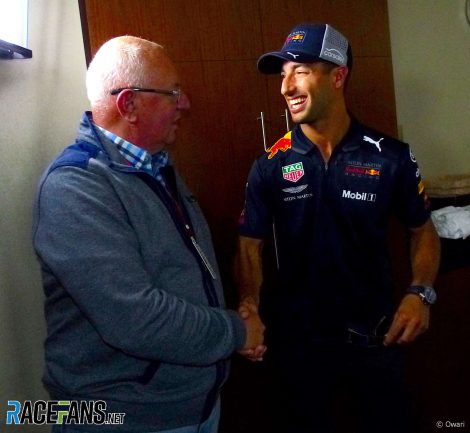 The other DR is quick with the quips and likes to poke fun at my accent (see last week’s press conference)This change of priorities which has taken root in F1 is best illustrated by (alleged) decrees that in-car footage of the Red Bulls be minimal as their Halos display TAG-Heuer logos, which could offend FOM sponsor Rolex.
The other DR is quick with the quips and likes to poke fun at my accent (see last week’s press conference)This change of priorities which has taken root in F1 is best illustrated by (alleged) decrees that in-car footage of the Red Bulls be minimal as their Halos display TAG-Heuer logos, which could offend FOM sponsor Rolex.
In many ways, though, F1 has improved: Since Mosley’s departure at the end of 2009 the paddock is a much calmer place. Ecclestone seemed to have mellowed before Liberty kicked him upstairs as ‘chairman emeritus”. Quite why he bothers to visit grands prix now remains, like so much about the man, a mystery. Hence why we called him ‘Mr E’…
The media facilities, too, have improved dramatically – back in the nineties Imola’s toilets were a disgrace, and Monza refused to even supply coffee to journalists – while the advent of the internet changed reporting beyond all recognition. Back in 1997 we sent reports by fax, and more than a few journalists travelled with Olivetti typewriters. Media centres even had dark rooms!
Internet journalists were then viewed with suspicion, and websites not accredited until the mid-noughties. Now, of course, every publication has a website, and folk think nothing of claiming quotes or even grabbing full credit for questions posed by others. No longer does one need to wait for Thursdays for news to break in weekly magazines; it is all instant now.
Relationships between the F1 media, governing body and FOM were often fractious, with threats to ‘pull passes’ unless one toed the party line being issued regularly. A memorable experience I had of this came after the 2012 Malaysian Grand Prix, when I was the first to reveal details of F1’s financial.
Advert | Become a RaceFans supporter and
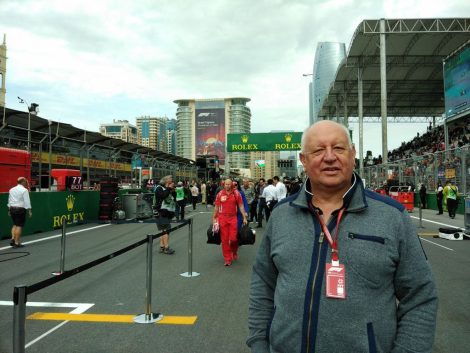 On the grid at Baku: 300 not outI endured numerous sleepless nights before we regrouped in China. I remember vividly the relief as my pass pinged rather than ponged as I swiped. Still, Bernie sent messages that he wished to speak to me on Sunday. When I asked for him I was told he’d left for Beijing that morning as Shanghai had played hard-ball with its contract extension. Never before or since have I loved the Shanghaies as much as on that bitterly cold morning. I now firmly believe my financial revelations brought crucial transparency to F1. Thus the risk was worth every palpitating heartbeat.
On the grid at Baku: 300 not outI endured numerous sleepless nights before we regrouped in China. I remember vividly the relief as my pass pinged rather than ponged as I swiped. Still, Bernie sent messages that he wished to speak to me on Sunday. When I asked for him I was told he’d left for Beijing that morning as Shanghai had played hard-ball with its contract extension. Never before or since have I loved the Shanghaies as much as on that bitterly cold morning. I now firmly believe my financial revelations brought crucial transparency to F1. Thus the risk was worth every palpitating heartbeat.
I am often asked three questions: Could I do 500 grands prix, which is favourite venue, and who is my favourite driver? The first is easy to answer: I am now 64, and cannot see myself putting in another ten years of intensive travel, so no.
The second question is slightly more complex: Each venue has its own character, and thus it depends on how one defines “favourite”: food, city, country, culture, circuit facilities, weather, etc. Clearly a city with vibrant nightlife holds greater appeal for 30-somethings than for greying geezers; equally, new venues provides new sets of experiences. On reflection, then, my favourite is always the next new venue.
As for drivers: The image one has of particular drivers as a fan differs vastly from their real-life personas. Often the most popular drivers amongst fans are not necessarily media favourites. Equally, some less successful drivers are hits with journalists yet, sadly, fans seldom get to know the real drivers inside the helmets.
One of my biggest pleasures has been to get to know – and mostly enjoy – the real people behind the balaclavas. Equally, meeting and being on good terms with (most) team bosses has been an utter pleasure. They, more than the drivers, are the true stars of F1, for no other business activity gets as closely scrutinised every fortnight by 500 million “experts”. Remember that the next time you criticise pit stop strategies.
When I first swiped my card at Silverstone 21 years ago I thought “If I never again manage to gain a pass, I’ve been there once.” After 300 grands prix it is all too easy to be blasé, yet every time I walk through the paddock I realise how blessed I really am to be paid to do what I love most. Of course it’s hard work; of course some days suck; of course I suffer jetlag.
But, to use a clichéd phrase: It sure beats working…
Follow Dieter on Twitter: @RacingLines
Go ad-free for just £1 per month
>> Find out more and sign up
